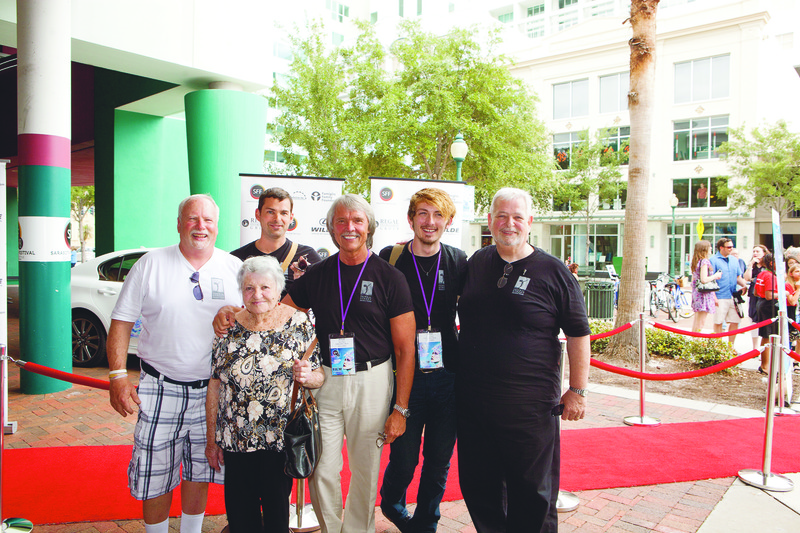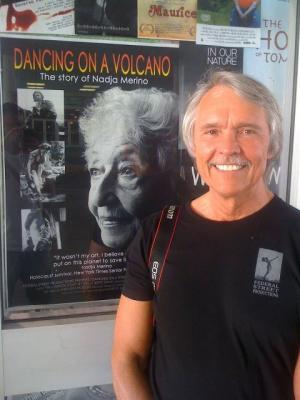Milton's Merz discovers Nazi-era hero
A kiss in 1939 is all it took to save hundreds of Austrian Jews and Christians from persecution and imprisonment by the Nazis during World War II. The story of that kiss and Nadja Merino, who gave it, is the subject of an emotional documentary by first-time Milton director Gary Merz.
Titled “Dancing On A Volcano,” the film premiered at the Sarasota Film Festival in April, where it finished second in the People's Choice Award competition for best documentary.
“It's quite an accomplishment for, literally, a group of amateurs to compete in a prestigious film festival like this and walk out as a runner-up,” said Merz, who owns Federal Street Gallery in Milton. “All of the people who were in charge of the Sarasota Film Festival came to us and told us we had an extraordinary piece of work, and they were so appreciative we showed down there.”
The film took four years to complete and took Merz and his crew around the world, from Chile to New York City to Berkley, Calif. The crew includes Lewes artist Abraxas Hudson as art director, former local photographer Alan Piñon and Joe Larrimore as videographers and Harbeson resident John C. Murray as narrator.
On a slim $25,000 budget, Merz produced a film that created such a buzz in Sarasota a third showing was added. It was the only film in the contest to receive an additional screening.
“It's an extraordinarily emotional film,” Merz said. “It touches people's hearts. It gives them a sense to look into their inner self to figure out who they are and what they're about.”
Nadja's story
The story begins with the kiss. Merino, now 100 years old, sought the help of Armando Marin, the Chilean consul general to Paris. In exchange for Merino's kiss, Marin agreed to grant visas for her family. The kiss led to a secret romance and influenced Marin to continue liberation efforts.
“We were given unprecedented access to the national archives of Chile and the Ministry of Chile,” Merz said. “They allowed us to go into their archives and, through discovery, we found he saved hundreds of Jews and Christians from Nazi persecution.”
Merz found Marin had helped people change their identities, passports and professions to meet criteria needed to get out of the country and accepted into Chile.
Merino moved to New York City in 1941, where she used her artistic talents to get a job as a senior illustrator for the New York Times. She also worked for Vogue, Vanity Fair, Harper and Revlon, among others.
All the while, Merz said, she carried a sense of guilt thinking she had caused Marin harm because he had worked to liberate so many persecuted individuals.
“He disappeared off the face of the Earth,” Merz said. “She thought he could've been executed or banished.”
But Marin's sense of duty and love of family led him back to Chile. In the making of the film, Merz discovered Marin died in 1960 in Chile; and broke the news to Merino during the making of the film.
“We were able to come back and tell her that there was nothing she had done to cause anything to hurt him.”
A Milton connection
The film debuted at Merino's 100th birthday party in New York City, where she's lived in the same apartment since 1947. Milton resident Patsy Cicala, Merino's nephew, was on hand to see it.
“Nadja had stories all the time, but it never connected,” he said. “It wasn't until Gary did all the research and produced the timeline that it all made sense.”
It was Cicala who brought Merz and Merino together. When Merino was 93 years old, Cicala brought a piece of Merino's art to his gallery to be framed. After inquiring who created the work, Merz contacted Merino. He traveled to New York City the next day and Merino consigned 140 pieces of art to Merz. The Federal Street Gallery in Milton hosted a highly successful show for Merino and, the next day, Merino gave a lecture at the gallery, where Merz and many local people heard bits and pieces of her incredible story. Merz stayed in contact and the next year after a second successful show Merino made a big decision.
“She put her forehead against my forehead and said she was going to give me a gift, a gift that would change my life,” Merz said. “She said, 'I want to give you my life story.'”
After six months of comtemplation, Merz decided he had to make the film. Only he felt Merino's story was better suited for a book first, a thought that guided the direction of the film.
“This film should've been a book first, so I produced the film as if it were in book form - it has a prologue, four chapters and an epilogue,” he said. “In essence I produced a motion picture book that circumvents the book.”
Merz next plans to take the film to the New Hope Film Festival in New Hope, Pa., in July and has been submitted to the Rehoboth Beach Film Festival in November.
The film was so warmly received in Sarasota, Merz said, he is exploring the option of making it into a full-length feature narrative film.
About the film festival
The Sarasota Film Festival is the fifth largest film festival in the country. Of the thousands of films entered, only 250 were accepted by the festival. “Dancing on a Volcano” finished second for the People's Choice Award by two tenths of one percent to a documentary titled “Ethel,” a film by Rory Kennedy about her mother.
Nick Roth is the news editor. He has been with the Cape Gazette since 2012, previously covering town beats in Milton and Lewes. In addition to serving on the editorial board and handling page layout, Nick is responsible for the weekly Delaware History in Photographs feature and enjoys writing stories about the Cape Region’s history. Prior to the Cape Gazette, Nick worked for the Delmarva Media Group, including the Delaware Wave, Delaware Coast Press and Salisbury Daily Times. He also contributed to The News Journal. Originally from Boyertown, Pa., Nick attended Shippensburg University in central Pennsylvania, graduating in 2007 with a bachelor’s degree in journalism. He’s won several MDDC awards during his career for both writing and photography. In his free time, he enjoys golfing, going to the beach with his family and cheering for Philadelphia sports teams.























































